| Listing 1 - 10 of 95 | << page >> |
Sort by
|
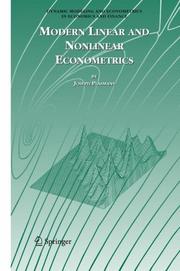
ISBN: 0387257608 9780387257600 0387257616 9780387257617 Year: 2006 Publisher: Dordrecht Springer
Abstract | Keywords | Export | Availability | Bookmark
 Loading...
Loading...Choose an application
- Reference Manager
- EndNote
- RefWorks (Direct export to RefWorks)
Quantitative methods (economics) --- AA / International- internationaal --- 305.0 --- Toegepaste econometrie en statistiek (algemene naslagwerken). Statistische onderzoekingen en studiën. --- Econometrics --- Toegepaste econometrie en statistiek (algemene naslagwerken). Statistische onderzoekingen en studiën --- Economics, Mathematical --- Statistics
Book
ISBN: 2225840695 Year: 1993 Volume: *2 Publisher: Paris ; Milan ; Barcelone Masson
Abstract | Keywords | Export | Availability | Bookmark
 Loading...
Loading...Choose an application
- Reference Manager
- EndNote
- RefWorks (Direct export to RefWorks)
AA / International- internationaal --- 300 --- 305.0 --- Algemene statistische naslagwerken. --- Toegepaste econometrie en statistiek (algemene naslagwerken). Statistische onderzoekingen en studiën. --- Economics --- Statistical methods --- Algemene statistische naslagwerken --- Toegepaste econometrie en statistiek (algemene naslagwerken). Statistische onderzoekingen en studiën --- STATISTIQUE APPLIQUEE --- SCIENCE ECONOMIQUE
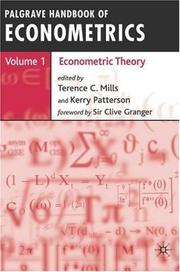
ISBN: 1403941556 9781403917997 1403918023 9781403941558 9781403918000 140391799X 9781403918024 1403918007 Year: 2006 Publisher: Basingstoke Palgrave
Abstract | Keywords | Export | Availability | Bookmark
 Loading...
Loading...Choose an application
- Reference Manager
- EndNote
- RefWorks (Direct export to RefWorks)
AA / International- internationaal --- 330.115 --- 305.0 --- Econometrie --- Toegepaste econometrie en statistiek (algemene naslagwerken). Statistische onderzoekingen en studiën. --- Econometrics. --- 330.115 Econometrie --- Econometrics --- Economics, Mathematical --- Statistics --- Toegepaste econometrie en statistiek (algemene naslagwerken). Statistische onderzoekingen en studiën
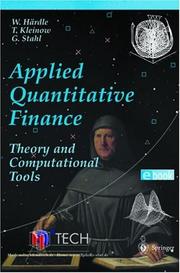
ISBN: 3540434607 Year: 2002 Publisher: Berlin Springer
Abstract | Keywords | Export | Availability | Bookmark
 Loading...
Loading...Choose an application
- Reference Manager
- EndNote
- RefWorks (Direct export to RefWorks)
Book
ISBN: 9780230271821 Year: 2011 Publisher: New York Palgrave Macmillan
Abstract | Keywords | Export | Availability | Bookmark
 Loading...
Loading...Choose an application
- Reference Manager
- EndNote
- RefWorks (Direct export to RefWorks)
Quantitative methods (economics) --- Econometrics --- 330.015195 --- 305.0 --- AA / International- internationaal --- Economics, Mathematical --- Statistics --- Data processing --- Statistical methods --- Toegepaste econometrie en statistiek (algemene naslagwerken). Statistische onderzoekingen en studiën
Book
ISBN: 9780199983421 9780199844371 0199844372 Year: 2016 Publisher: New York City Oxford University Press
Abstract | Keywords | Export | Availability | Bookmark
 Loading...
Loading...Choose an application
- Reference Manager
- EndNote
- RefWorks (Direct export to RefWorks)
Being published as a celebration of the 60th anniversary of John von Neumann’s “Theory of Self-Reproducing Automata,” this handbook attempts to provide a unique reflection on the nature of computational economics and finance (CEF) in light of natural computationalism. We restructure CEF by including both nature-inspired computing and natural computing. This new framework allows us to have a view of CEF much broader than just the conventional algorithmic consideration. The book begins with a historical review of computational economics (CE), tracing its history far back to the era of analog computing. In these early days, advancements were mainly made using the idea of natural computing, and the subjects pursued by CE were the computing system as a whole, not just numerical computing. The handbook then is organized by distinguishing computing from computing systems. Six chapters (Chapters 2 to 7) are devoted to the former. They together present a review on the recent progresses in CE, as illustrated by the computation of rational expectations, general equilibrium, risk, and volatility. The subsequent 16 chapters are devoted to the computing-systemic view of CE, including natural-inspired computing (Chapters 8 to 12) and network, agent-based computing and neural computing (Chapters 13 to 23). In addition to providing alternative approaches to forecasting, investment strategies and risk management, etc., they enable us to have a 'natural' or more realistic description of the economy, starting from its decision makers; hence, market-design or policy-design issues involving different levels of the economy, be microscopic, mesoscopic and macroscopic, can be simultaneously addressed and coherently integrated. The handbook concludes with a chapter on what we may hope from CE by providing an in-depth review on the epistemological aspects of computation.
Economics --- Economics, Mathematical --- Finance --- 305.0 --- Mathematical economics --- Econometrics --- Mathematics --- Data processing --- Toegepaste econometrie en statistiek (algemene naslagwerken). Statistische onderzoekingen en studiën --- Methodology
Book
ISBN: 9780691152875 069115287X Year: 2011 Publisher: Princeton Princeton university
Abstract | Keywords | Export | Availability | Bookmark
 Loading...
Loading...Choose an application
- Reference Manager
- EndNote
- RefWorks (Direct export to RefWorks)
Macroeconomics --- Econometric models --- AA / International- internationaal --- 305.0 --- 330.3 --- Toegepaste econometrie en statistiek (algemene naslagwerken). Statistische onderzoekingen en studiën. --- Methode in staathuishoudkunde. Statische, dynamische economie. Modellen. Experimental economics. --- Economics --- Toegepaste econometrie en statistiek (algemene naslagwerken). Statistische onderzoekingen en studiën --- Methode in staathuishoudkunde. Statische, dynamische economie. Modellen. Experimental economics --- Macroeconomics - Econometric models
Book
ISBN: 9780273753568 9780131395381 0131395386 0273753568 Year: 2012 Publisher: Harlow Pearson Education
Abstract | Keywords | Export | Availability | Bookmark
 Loading...
Loading...Choose an application
- Reference Manager
- EndNote
- RefWorks (Direct export to RefWorks)
Mathematical statistics --- Quantitative methods (economics) --- Econometrics. --- Econométrie --- Économétrie --- Econometrics --- 330.015195 --- Economics, Mathematical --- Statistics --- AA / International- internationaal --- 303.8 --- 305.0 --- 330.115 --- Econometrische behandeling van een onderwerp. --- Toegepaste econometrie en statistiek (algemene naslagwerken). Statistische onderzoekingen en studiën. --- Econometrie --- 330.115 Econometrie --- Econométrie --- Économétrie. --- Econometrische behandeling van een onderwerp --- Toegepaste econometrie en statistiek (algemene naslagwerken). Statistische onderzoekingen en studiën
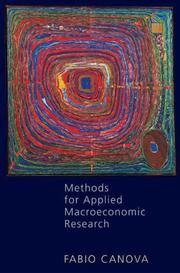
ISBN: 9780691115047 0691115044 Year: 2007 Publisher: Princeton (N.J.) : Princeton University Press,
Abstract | Keywords | Export | Availability | Bookmark
 Loading...
Loading...Choose an application
- Reference Manager
- EndNote
- RefWorks (Direct export to RefWorks)
The last twenty years have witnessed tremendous advances in the mathematical, statistical, and computational tools available to applied macroeconomists. This rapidly evolving field has redefined how researchers test models and validate theories. Yet until now there has been no textbook that unites the latest methods and bridges the divide between theoretical and applied work. Fabio Canova brings together dynamic equilibrium theory, data analysis, and advanced econometric and computational methods to provide the first comprehensive set of techniques for use by academic economists as well as professional macroeconomists in banking and finance, industry, and government. This graduate-level textbook is for readers knowledgeable in modern macroeconomic theory, econometrics, and computational programming using RATS, MATLAB, or Gauss. Inevitably a modern treatment of such a complex topic requires a quantitative perspective, a solid dynamic theory background, and the development of empirical and numerical methods--which is where Canova's book differs from typical graduate textbooks in macroeconomics and econometrics. Rather than list a series of estimators and their properties, Canova starts from a class of DSGE models, finds an approximate linear representation for the decision rules, and describes methods needed to estimate their parameters, examining their fit to the data. The book is complete with numerous examples and exercises. Today's economic analysts need a strong foundation in both theory and application. 'Methods for Applied Macroeconomic Research' offers the essential tools for the next generation of macroeconomists.
Macroeconomics --- Quantitative methods (economics) --- Research --- Methodology --- Mathematical models --- AA / International- internationaal --- 305.0 --- -Macroeconomics --- -339.0724 --- Economics --- Toegepaste econometrie en statistiek (algemene naslagwerken). Statistische onderzoekingen en studiën. --- Econometric models --- Mathematical models. --- Methodology. --- 339.0724 --- Research&delete& --- Toegepaste econometrie en statistiek (algemene naslagwerken). Statistische onderzoekingen en studiën --- Macroeconomics - Research - Methodology --- Macroeconomics - Mathematical models
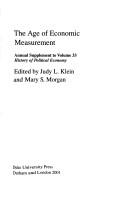
ISBN: 0822365170 9780822365174 Year: 2001 Volume: 33 Publisher: Durham Duke university press
Abstract | Keywords | Export | Availability | Bookmark
 Loading...
Loading...Choose an application
- Reference Manager
- EndNote
- RefWorks (Direct export to RefWorks)
Economic schools --- Economie politique --- Mathématiques économiques --- Methodes statistiques --- AA / International- internationaal --- 331.166 --- 305.0 --- Geschiedenis van de statistiek. --- Toegepaste econometrie en statistiek (algemene naslagwerken). Statistische onderzoekingen en studiën. --- Économie politique --- Méthodes statistiques --- Geschiedenis van de statistiek --- Toegepaste econometrie en statistiek (algemene naslagwerken). Statistische onderzoekingen en studiën --- Économie politique - Méthodes statistiques
| Listing 1 - 10 of 95 | << page >> |
Sort by
|

 Search
Search Feedback
Feedback About
About Help
Help News
News